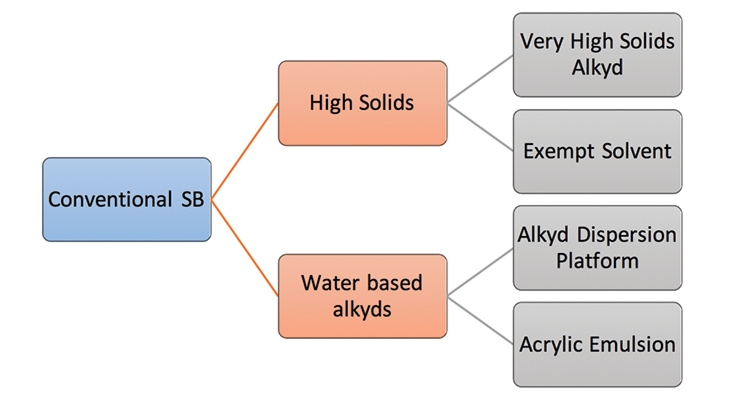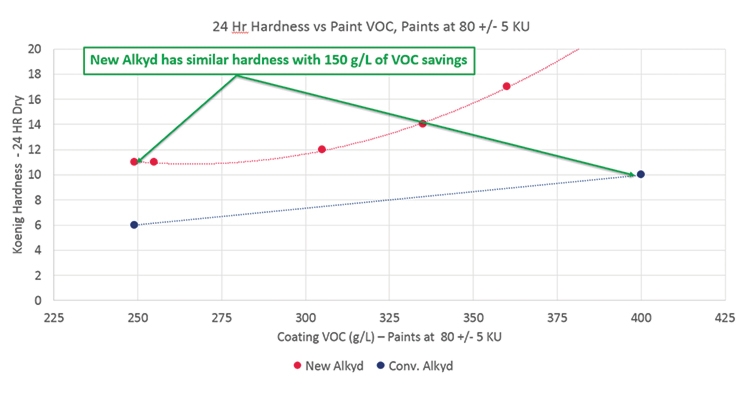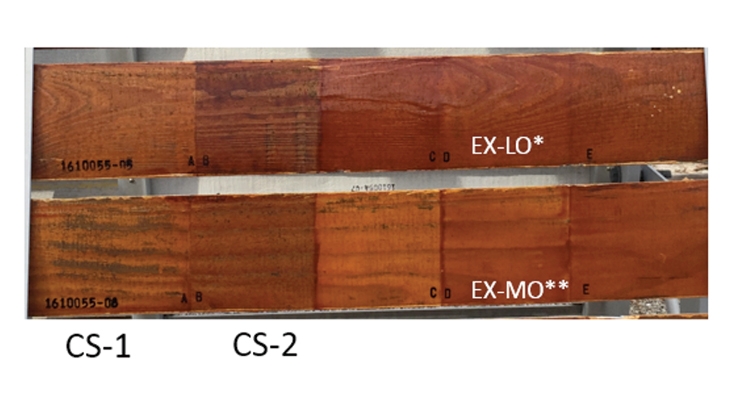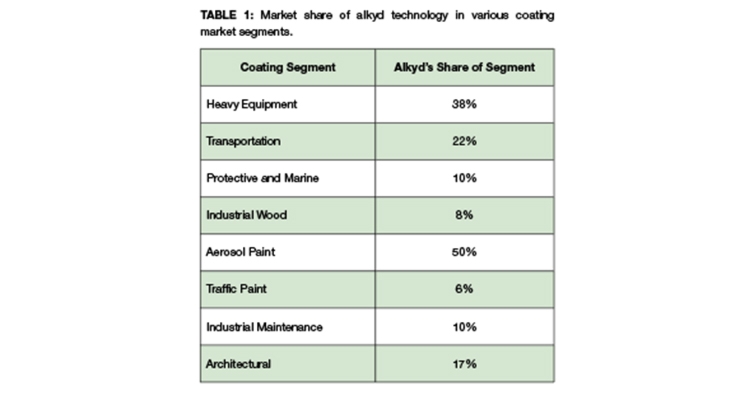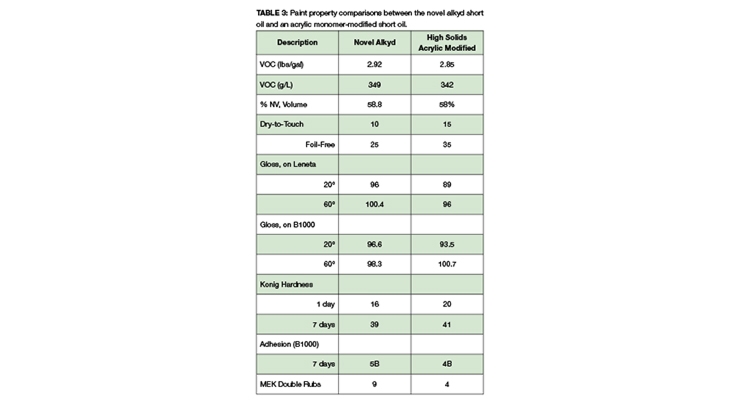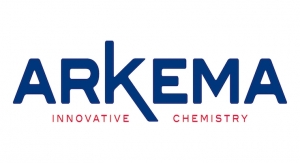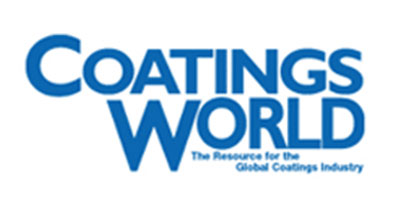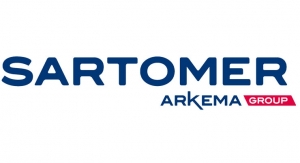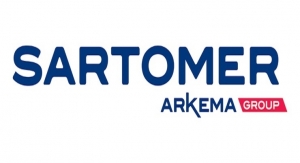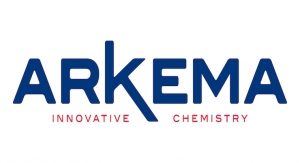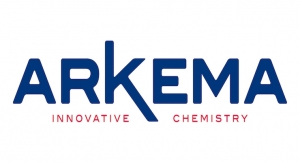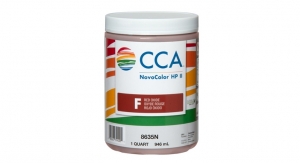Jeffrey Arendt and Jun Kim, Arkema Coating Resins, USA07.03.19
Abstract
In many market segments alkyd technology offers a value proposition unmatched by other coating technologies. As a result alkyds maintain significant share in these segments. Increasing market trends toward sustainability are creating a need to adapt the technology without sacrificing coating performance. High solids, exempt solvents and waterborne approaches are often evaluated when aiming to reduce the VOC of alkyd coatings. Exempt solvents face limitations in odor, solubility, cost, flash point and geographic compliance. Waterborne performance is improving, however gaps in performance and aesthetics still exist. For the end-user, high solids approaches require the least investment and are often the simplest approach to meeting VOC targets.
Historically moving to high solids has come with a compromise in dry time and hardness. With this in mind, the authors of this paper have continued to advance high-solids alkyds and have developed a new alkyd platform. The new platform expands performance in the high-solids space and is useful for creating alkyds and modified alkyd polymers that offer low VOC, low viscosity and fast dry benefits. Differing from some other high solids approaches, this new platform is derived from readily available feedstock materials and is commercially viable. This paper reviews the versatility of this new technology platform and demonstrates coating applications that can improve their performance/VOC balance using this development. Applications span across both Architectural and Industrial markets, including: ACE, maintenance, wood, and decorative coatings.
Introduction
With a history of proven performance in architectural and industrial coatings and the ability to adhere to less-than-ideally prepared substrates, alkyd resins have remained at the forefront of coating technology for well over 50 years. With such an established history, alkyds are often thought of as old technology and often synonymously associated with environmental compliance issues.
Such historical associations are not the contemporary story. New technology has been developed to take alkyd technology into the future. This paper discusses applications for an innovative alkyd platform designed to solve performance challenges observed when reformulating solvent-based alkyds to meet increasing consumer demands and tighter environmental regulations.
This novel alkyd platform allows for faster surface dry and earlier hardness development at reduced VOC.
Alkyd technology originated in the mid-1920s. At that time drying oils were often used, however drying oils lacked the durability needed to advance coating performance. Scientists combined polyester technology with air drying oils to create oxidatively-curable alkyd resins. This invention improved upon the properties of drying oils and polyesters. Unmodified polyester resins do not air dry. Alkyds are modified polyesters that can air dry. The alkyd resins developed offered improved coating durability over drying oils. As the industry advanced, numerous alkyd and modified alkyd resins were created demonstrating the versatility of alkyd technology for coating applications.
To manufacture a solvent-based alkyd paint a coating producer will use an alkyd polymer supplied as a concentrated resin solution. Coating manufacturers disperse pigment into the resin solution and add solvent to the system to reduce the viscosity to the desired application viscosity. In the industry today the use of solvents is regulated as most common solvents qualify as volatile organic compounds (VOCs). With increasing consumer pressure and increasing environmental regulations there exists a need to reduce the VOCs in solvent-based coatings. It is this need that inspired the work of this research team to develop a novel alkyd platform to aid the coating manufacturer in VOC reduction while maintaining the performance levels higher-VOC coatings are known for.
Marketing data shows water-based coatings are on the rise and this paper’s authors have demonstrated novel water-based alkyd technology for VOC reduction.1 At the same time, there are situations where water-based coatings have not been able to meet the application parameters required. An example of this is the metal coatings industry. Solvent-based alkyds continue to hold a significant position in the metal coating industry as a result of their cost/performance balance. The ISO 12944 standard is intended to assist engineers and corrosion experts in adopting best practice in corrosion protection of structural steel at new construction. A cursory review of major coatings manufacturer’s recommendations for ISO 12994 rarely turns up a latex paint recommendation. The minimum performance recommendation for this standard generally consists of solvent-based alkyds.
Water-based coatings have certain inherent challenges and limitations that researchers still need to overcome to replace alkyds in all markets. An unavoidable limitation of water-based technology is caused by the high surface tension of water. To overcome this, high levels of surfactant are needed. Also, because water-based resins generally do not thicken the water phase, high levels of water soluble rheology modifier are needed. Solvent-based alkyd coatings require fewer additives than water-based coatings. With minimal additive requirements solvent-based coatings are easier to formulate for water resistance, corrosion resistance, and adhesion.
Alkyd coatings develop properties and molecular weight via an oxidative curing mechanism. This curing mechanism remains a significant technology for creating easy to use, cost effective, one-component coatings. Alkyd coatings begin the filming process with a low molecular weight. Starting the filming process with a low molecular weight allows for better substrate wetting and flow into the substrate (i.e., the cellular structure of wood) if the substrate is porous. This type of polymer flow is not possible with a high-molecular-weight polymer. This high degree of polymer flow also enables alkyds to achieve superior gloss. After wetting the substrate, the solvent begins to evaporate and the alkyd begins crosslinking with atmospheric oxygen. Crosslinking increases the molecular weight of the coating system developing the needed mechanical properties. A primer on this technology can be found in other publications.2 Over the years the performance, cost and versatility of alkyd technology has resulted in this polymer technology holding significant share in almost all coatings markets. In markets where alkyd coatings are still used today it is often difficult to replace this technology without trading off a performance property, paying a higher cost, or investing in new coating applications procedures and equipment.
Alkyd Coatings Market
Almost all major coating segments in the United States use alkyd resins. Table 1 indicates the share of each coating market segment that uses alkyd resins.3
In these segments alkyd technology maintains a share of the segment because of the value and performance offered. If VOC levels are tightened these segments may need to replace their current technology with a lower-VOC capable technology.
High-solids alkyds are an option for compliance. High-solids systems can be applied using conventional spray equipment with minor modifications. Also, high-solids alkyds can be blended with conventional alkyds to lower the total VOC emitted. The challenge with moving to high solids is to maintain performance.
The Problem - Alkyd VOC Challenges and Current Approaches
As noted in Table 1, alkyds have a prominent share position in most major coating markets. With evolving consumer preferences and increasing environmental regulations acting upon coating manufactures there is a need to develop lower-VOC coatings with minimal change in performance. Figure 1 outlines the evolution alkyd technology has undergone as markets and technology have responded to comply with tightening VOC regulations.
As we move from left to right (in Figure 1) each of these technologies has advantages and disadvantages. Waterborne approaches were discussed earlier in this paper and are covered in detail in other papers. Advances have been made, however performance challenges still exist making the high-solids paths the easier approach to take to achieve compliance and performance.
Exempt solvents are solvents that do not need to be counted as a VOC. Some examples include para-chlorobenzotrifluoride (Oxsol 100), acetone, t-butyl acetate, VMS fluids, methyl acetate and di-methyl carbonate. These solvents are exempt from the VOC calculations in most United States areas. In principle the use of exempt solvents is a terrific solution for VOC reduction.
Simply exchange the solvent and maintain performance. In practice the exchange of these solvents is not simple. Each of these solvents has its own challenges in solvency, cost, evaporation rate, stability and performance. Furthermore, not all exempt solvents are recognized as exempt in all air districts and there are increasingly more local air districts to comply with.4 Exempt solvent can be an approach to compliance, however we will not take this approach in this paper as we believe a polymer approach is a more broadly applicable solution to compliance and performance.
To understand how VOC reduction occurs when moving to high solids, Table 2 shows the relationship between the volume solids and the VOC of a coating thinned with butyl acetate solvent. To achieve a VOC of 250 g/L, the coating will require 72% of its volume to be comprised of non-volatiles. To achieve such high solids and allow for good atomization with normal sprayers, the resin must have a low viscosity while also having all the other required technical performance properties needed for each end-use application.
To achieve higher solids the formulator must load more non-volatiles into the coating. A significant portion of the added non-volatiles is resin. To load in more resin and achieve a low application viscosity requires that the resin have a low viscosity.
Typically what is seen is a large fall off in dry time and hardness development as the resin’s molecular weight is lowered to achieve a low viscosity. A low-molecular-weight resin requires more time and more crosslinks to build to properties than a high-molecular-weight resin.
There are several approaches that can be taken to lower the viscosity of alkyd polymers thereby allowing for higher-solids formulations. These approaches include: lowering the molecular weight, increasing the fatty acid amount, building a highly branched polymer structure, and focusing on a narrow molecular weight distribution. Decreasing the molecular weight and increasing levels of a fatty acid does lower viscosity, however this comes at the expense of other coating properties. On the other hand, building a highly branched polymer structure and achieving narrow molecular weight distribution requires high-cost raw materials and a tedious long batch process.
A Potential Solution – A New Technology Platform for Alkyds
To solve these challenges we have developed a new alkyd technology platform. This platform builds upon the experience gained through the commercial manufacturing of previous generations of high-solids alkyds. The new platform delivers faster dry times and higher hardness than the standard approaches used to make high-solids alkyds. This technology has been designed to utilize feedstock raw materials that are readily available today and viable long term in the marketplace.
Using this platform’s technology in conjunction with known structure property rules of alkyd polymer design it is possible to create novel alkyd products spanning the entire alkyd performance spectrum. Figure 2 outlines some of the modification paths that are possible using this novel alkyd platform technology. The novel alkyd may be modified to make long-, medium-, and short-oil alkyds. It is also possible to monomer-modify this alkyd for further performance tailoring. As this is a baseline review of the technology, none of the novel alkyd prototypes presented in this paper are monomer modified.
To understand the capabilities of the novel alkyd platform this paper presents performance data from different applications comparing the novel alkyd against a similar oil length conventional alkyd.
Long Oil
The data in Figures 3 and 4 was obtained using alkyd resin samples cooked to the molecular weight required for achieving a constant paint viscosity (80 KU) over a distribution of paint VOCs. This shows how molecular weight affects coating performance for conventional alkyds and for the novel alkyd approach. In general high-VOC coatings have high-molecular-weight resins. All paints were formulated with TiO2 as the sole pigment and mineral spirits as the only solvent.
Figure 3 demonstrates the dry time capability of the novel alkyd platform vs a conventional alkyd across the VOC spectrum. A lower value indicates a faster dry. The new alkyd polymer offers faster dry. Note the dry time achieved with the new alkyd at 300 g/L is similar to the conventional alkyd’s dry time at 400 g/l. The novel alkyd offers 100 g/L of VOC savings at a similar dry time.
Alternatively on the low VOC side of the data plot, the dry time for the novel alkyd is twice as fast as the conventional approach to achieving low VOC.
The hardness development is plotted in Figure 4. In Figure 3 we saw that the novel alkyd platform dries faster than conventional approaches for making high-solids resin. In Figure 4 we see that the novel alkyd also delivers higher hardness than conventional alkyd manufacturing approaches regardless of the VOC/molecular weight. In the 250 g/L paint the novel alkyd platform delivered similar hardness after one day of dry as the conventional alkyd at 400 g/L.
The data in Figures 3 and 4 shows that the novel alkyd/new alkyd platform dries faster and harder than conventional synthesis approaches for making high-solids alkyds.
In this study the novel long oil alkyd resin developed for the 250 g/L paint is a 100% solids long oil with a dry time of 12-15 hours. Ongoing optimization has shown this can be improved upon, however this will not be reviewed in this paper as the goal for this paper is to demonstrate the platform and not an individual product.
Novel Long Oil and Novel Medium Oil in a Wood Stain Application
Using a 100% solids long oil derived from the platform described above and a 90% solids medium oil (also made using this platform’s technology) transparent oxide wood stains were formulated and compared against commercially purchased transparent oxide wood stains from leading consumer brands. The comparisons appear in Photo 1. Using the novel long oil (EX-LO) to create a 250 g/L wood stain resulted in a stain with a viscosity of 56 KU’s. Using the novel alkyd medium oil (EX-MO) to make the same 250 g/L wood stain resulted in a viscosity of 92 KU’s. No UV absorbers were added to the stains.
The exposure data in Photo 1 shows the novel alkyd prototypes without UV absorbers performing as good as, or better than, the commercial stains after 15 months of exposure. Commercial stains are labelled as CS1 and CS2. The commercial stains appear on each board in the spot directly above their label. CS1 appears on both boards in position A and CS2 appears on both boards in position B. Gloss, color, crack resistance and overall appearance for the novel long oil and the novel medium oil vs the commercial controls was very good. The advantage of using the long oil is that this resin gives a lower viscosity than the medium oil.
Novel Short Oil in a Metal Coating Application
The novel alkyd utilizes drying oils/fatty acids to air dry just like conventional alkyds. In the higher oil length formulas the novel alkyd platform is more constrained by these higher oil/fatty acid levels. In the next example we will review a short oil created using the new platform. Dry time for the novel alkyd short oil was noted to be very fast. Therefore we will compare it to a monomer-modified alkyd. The novel alkyd short oil is not monomer modified. Monomer modification is often done to enhance the dry time of an alkyd. Both the novel alkyd short oil paint and the monomer modified paint were formulated to ~350 g/L and a similar viscosity was obtained. The results appear in Table 3.
The novel alkyd short oil dries faster than the acrylic-modified alkyd and offers similar hardness. The novel alkyd was observed as having better adhesion.
Summary
As coating VOCs have reduced the standard approaches for creating high-solids, alkyds have not been able to maintain performance at low VOC. To maintain performance in higher-solids alkyd systems Arkema has developed a new technology platform that can be leveraged across the alkyd polymer design space creating high-solids alkyds with notable dry time and hardness improvements.
Technology from this platform offers the coating formulator a high level of flexibility and an easier path to VOC reduction. Alkyds from this novel platform formulate like a traditional alkyd. Traditional oil length monikers (long, medium, short) are used to designate modifications of this technology. The new platform does not require exempt solvent. It can be formulated with or without exempt solvent.
The new platform is commercially viable and allows coatings formulators to mitigate performance losses in dry time and hardness development when formulating lower-VOC alkyd coatings.
References
1. A New Platform Technology for Alkyds. Eliminating Emulsification Surfactants to Breach the Performance Gaps between Water-Based and Solvent-Based Alkyd Coatings, J. Arendt and J. Kim, 2016 American Coatings Conference
2. Organic Coatings: Science and Technology Third Edition, Zeno Wicks et.al., Chapter 15
3. 2010 American Coatings Association Industry Marketing Analysis
4. Update: U.S. EPA Exempt Volatile Organic Compounds, David Darling, ACA Communication, 2/4/2018
In many market segments alkyd technology offers a value proposition unmatched by other coating technologies. As a result alkyds maintain significant share in these segments. Increasing market trends toward sustainability are creating a need to adapt the technology without sacrificing coating performance. High solids, exempt solvents and waterborne approaches are often evaluated when aiming to reduce the VOC of alkyd coatings. Exempt solvents face limitations in odor, solubility, cost, flash point and geographic compliance. Waterborne performance is improving, however gaps in performance and aesthetics still exist. For the end-user, high solids approaches require the least investment and are often the simplest approach to meeting VOC targets.
Historically moving to high solids has come with a compromise in dry time and hardness. With this in mind, the authors of this paper have continued to advance high-solids alkyds and have developed a new alkyd platform. The new platform expands performance in the high-solids space and is useful for creating alkyds and modified alkyd polymers that offer low VOC, low viscosity and fast dry benefits. Differing from some other high solids approaches, this new platform is derived from readily available feedstock materials and is commercially viable. This paper reviews the versatility of this new technology platform and demonstrates coating applications that can improve their performance/VOC balance using this development. Applications span across both Architectural and Industrial markets, including: ACE, maintenance, wood, and decorative coatings.
Introduction
With a history of proven performance in architectural and industrial coatings and the ability to adhere to less-than-ideally prepared substrates, alkyd resins have remained at the forefront of coating technology for well over 50 years. With such an established history, alkyds are often thought of as old technology and often synonymously associated with environmental compliance issues.
Such historical associations are not the contemporary story. New technology has been developed to take alkyd technology into the future. This paper discusses applications for an innovative alkyd platform designed to solve performance challenges observed when reformulating solvent-based alkyds to meet increasing consumer demands and tighter environmental regulations.
This novel alkyd platform allows for faster surface dry and earlier hardness development at reduced VOC.
Alkyd technology originated in the mid-1920s. At that time drying oils were often used, however drying oils lacked the durability needed to advance coating performance. Scientists combined polyester technology with air drying oils to create oxidatively-curable alkyd resins. This invention improved upon the properties of drying oils and polyesters. Unmodified polyester resins do not air dry. Alkyds are modified polyesters that can air dry. The alkyd resins developed offered improved coating durability over drying oils. As the industry advanced, numerous alkyd and modified alkyd resins were created demonstrating the versatility of alkyd technology for coating applications.
To manufacture a solvent-based alkyd paint a coating producer will use an alkyd polymer supplied as a concentrated resin solution. Coating manufacturers disperse pigment into the resin solution and add solvent to the system to reduce the viscosity to the desired application viscosity. In the industry today the use of solvents is regulated as most common solvents qualify as volatile organic compounds (VOCs). With increasing consumer pressure and increasing environmental regulations there exists a need to reduce the VOCs in solvent-based coatings. It is this need that inspired the work of this research team to develop a novel alkyd platform to aid the coating manufacturer in VOC reduction while maintaining the performance levels higher-VOC coatings are known for.
Marketing data shows water-based coatings are on the rise and this paper’s authors have demonstrated novel water-based alkyd technology for VOC reduction.1 At the same time, there are situations where water-based coatings have not been able to meet the application parameters required. An example of this is the metal coatings industry. Solvent-based alkyds continue to hold a significant position in the metal coating industry as a result of their cost/performance balance. The ISO 12944 standard is intended to assist engineers and corrosion experts in adopting best practice in corrosion protection of structural steel at new construction. A cursory review of major coatings manufacturer’s recommendations for ISO 12994 rarely turns up a latex paint recommendation. The minimum performance recommendation for this standard generally consists of solvent-based alkyds.
Water-based coatings have certain inherent challenges and limitations that researchers still need to overcome to replace alkyds in all markets. An unavoidable limitation of water-based technology is caused by the high surface tension of water. To overcome this, high levels of surfactant are needed. Also, because water-based resins generally do not thicken the water phase, high levels of water soluble rheology modifier are needed. Solvent-based alkyd coatings require fewer additives than water-based coatings. With minimal additive requirements solvent-based coatings are easier to formulate for water resistance, corrosion resistance, and adhesion.
Alkyd coatings develop properties and molecular weight via an oxidative curing mechanism. This curing mechanism remains a significant technology for creating easy to use, cost effective, one-component coatings. Alkyd coatings begin the filming process with a low molecular weight. Starting the filming process with a low molecular weight allows for better substrate wetting and flow into the substrate (i.e., the cellular structure of wood) if the substrate is porous. This type of polymer flow is not possible with a high-molecular-weight polymer. This high degree of polymer flow also enables alkyds to achieve superior gloss. After wetting the substrate, the solvent begins to evaporate and the alkyd begins crosslinking with atmospheric oxygen. Crosslinking increases the molecular weight of the coating system developing the needed mechanical properties. A primer on this technology can be found in other publications.2 Over the years the performance, cost and versatility of alkyd technology has resulted in this polymer technology holding significant share in almost all coatings markets. In markets where alkyd coatings are still used today it is often difficult to replace this technology without trading off a performance property, paying a higher cost, or investing in new coating applications procedures and equipment.
Alkyd Coatings Market
Almost all major coating segments in the United States use alkyd resins. Table 1 indicates the share of each coating market segment that uses alkyd resins.3
In these segments alkyd technology maintains a share of the segment because of the value and performance offered. If VOC levels are tightened these segments may need to replace their current technology with a lower-VOC capable technology.
High-solids alkyds are an option for compliance. High-solids systems can be applied using conventional spray equipment with minor modifications. Also, high-solids alkyds can be blended with conventional alkyds to lower the total VOC emitted. The challenge with moving to high solids is to maintain performance.
The Problem - Alkyd VOC Challenges and Current Approaches
As noted in Table 1, alkyds have a prominent share position in most major coating markets. With evolving consumer preferences and increasing environmental regulations acting upon coating manufactures there is a need to develop lower-VOC coatings with minimal change in performance. Figure 1 outlines the evolution alkyd technology has undergone as markets and technology have responded to comply with tightening VOC regulations.
As we move from left to right (in Figure 1) each of these technologies has advantages and disadvantages. Waterborne approaches were discussed earlier in this paper and are covered in detail in other papers. Advances have been made, however performance challenges still exist making the high-solids paths the easier approach to take to achieve compliance and performance.
Exempt solvents are solvents that do not need to be counted as a VOC. Some examples include para-chlorobenzotrifluoride (Oxsol 100), acetone, t-butyl acetate, VMS fluids, methyl acetate and di-methyl carbonate. These solvents are exempt from the VOC calculations in most United States areas. In principle the use of exempt solvents is a terrific solution for VOC reduction.
Simply exchange the solvent and maintain performance. In practice the exchange of these solvents is not simple. Each of these solvents has its own challenges in solvency, cost, evaporation rate, stability and performance. Furthermore, not all exempt solvents are recognized as exempt in all air districts and there are increasingly more local air districts to comply with.4 Exempt solvent can be an approach to compliance, however we will not take this approach in this paper as we believe a polymer approach is a more broadly applicable solution to compliance and performance.
To understand how VOC reduction occurs when moving to high solids, Table 2 shows the relationship between the volume solids and the VOC of a coating thinned with butyl acetate solvent. To achieve a VOC of 250 g/L, the coating will require 72% of its volume to be comprised of non-volatiles. To achieve such high solids and allow for good atomization with normal sprayers, the resin must have a low viscosity while also having all the other required technical performance properties needed for each end-use application.
To achieve higher solids the formulator must load more non-volatiles into the coating. A significant portion of the added non-volatiles is resin. To load in more resin and achieve a low application viscosity requires that the resin have a low viscosity.
Typically what is seen is a large fall off in dry time and hardness development as the resin’s molecular weight is lowered to achieve a low viscosity. A low-molecular-weight resin requires more time and more crosslinks to build to properties than a high-molecular-weight resin.
There are several approaches that can be taken to lower the viscosity of alkyd polymers thereby allowing for higher-solids formulations. These approaches include: lowering the molecular weight, increasing the fatty acid amount, building a highly branched polymer structure, and focusing on a narrow molecular weight distribution. Decreasing the molecular weight and increasing levels of a fatty acid does lower viscosity, however this comes at the expense of other coating properties. On the other hand, building a highly branched polymer structure and achieving narrow molecular weight distribution requires high-cost raw materials and a tedious long batch process.
A Potential Solution – A New Technology Platform for Alkyds
To solve these challenges we have developed a new alkyd technology platform. This platform builds upon the experience gained through the commercial manufacturing of previous generations of high-solids alkyds. The new platform delivers faster dry times and higher hardness than the standard approaches used to make high-solids alkyds. This technology has been designed to utilize feedstock raw materials that are readily available today and viable long term in the marketplace.
Using this platform’s technology in conjunction with known structure property rules of alkyd polymer design it is possible to create novel alkyd products spanning the entire alkyd performance spectrum. Figure 2 outlines some of the modification paths that are possible using this novel alkyd platform technology. The novel alkyd may be modified to make long-, medium-, and short-oil alkyds. It is also possible to monomer-modify this alkyd for further performance tailoring. As this is a baseline review of the technology, none of the novel alkyd prototypes presented in this paper are monomer modified.
To understand the capabilities of the novel alkyd platform this paper presents performance data from different applications comparing the novel alkyd against a similar oil length conventional alkyd.
Long Oil
The data in Figures 3 and 4 was obtained using alkyd resin samples cooked to the molecular weight required for achieving a constant paint viscosity (80 KU) over a distribution of paint VOCs. This shows how molecular weight affects coating performance for conventional alkyds and for the novel alkyd approach. In general high-VOC coatings have high-molecular-weight resins. All paints were formulated with TiO2 as the sole pigment and mineral spirits as the only solvent.
Figure 3 demonstrates the dry time capability of the novel alkyd platform vs a conventional alkyd across the VOC spectrum. A lower value indicates a faster dry. The new alkyd polymer offers faster dry. Note the dry time achieved with the new alkyd at 300 g/L is similar to the conventional alkyd’s dry time at 400 g/l. The novel alkyd offers 100 g/L of VOC savings at a similar dry time.
Alternatively on the low VOC side of the data plot, the dry time for the novel alkyd is twice as fast as the conventional approach to achieving low VOC.
The hardness development is plotted in Figure 4. In Figure 3 we saw that the novel alkyd platform dries faster than conventional approaches for making high-solids resin. In Figure 4 we see that the novel alkyd also delivers higher hardness than conventional alkyd manufacturing approaches regardless of the VOC/molecular weight. In the 250 g/L paint the novel alkyd platform delivered similar hardness after one day of dry as the conventional alkyd at 400 g/L.
The data in Figures 3 and 4 shows that the novel alkyd/new alkyd platform dries faster and harder than conventional synthesis approaches for making high-solids alkyds.
In this study the novel long oil alkyd resin developed for the 250 g/L paint is a 100% solids long oil with a dry time of 12-15 hours. Ongoing optimization has shown this can be improved upon, however this will not be reviewed in this paper as the goal for this paper is to demonstrate the platform and not an individual product.
Novel Long Oil and Novel Medium Oil in a Wood Stain Application
Using a 100% solids long oil derived from the platform described above and a 90% solids medium oil (also made using this platform’s technology) transparent oxide wood stains were formulated and compared against commercially purchased transparent oxide wood stains from leading consumer brands. The comparisons appear in Photo 1. Using the novel long oil (EX-LO) to create a 250 g/L wood stain resulted in a stain with a viscosity of 56 KU’s. Using the novel alkyd medium oil (EX-MO) to make the same 250 g/L wood stain resulted in a viscosity of 92 KU’s. No UV absorbers were added to the stains.
The exposure data in Photo 1 shows the novel alkyd prototypes without UV absorbers performing as good as, or better than, the commercial stains after 15 months of exposure. Commercial stains are labelled as CS1 and CS2. The commercial stains appear on each board in the spot directly above their label. CS1 appears on both boards in position A and CS2 appears on both boards in position B. Gloss, color, crack resistance and overall appearance for the novel long oil and the novel medium oil vs the commercial controls was very good. The advantage of using the long oil is that this resin gives a lower viscosity than the medium oil.
Novel Short Oil in a Metal Coating Application
The novel alkyd utilizes drying oils/fatty acids to air dry just like conventional alkyds. In the higher oil length formulas the novel alkyd platform is more constrained by these higher oil/fatty acid levels. In the next example we will review a short oil created using the new platform. Dry time for the novel alkyd short oil was noted to be very fast. Therefore we will compare it to a monomer-modified alkyd. The novel alkyd short oil is not monomer modified. Monomer modification is often done to enhance the dry time of an alkyd. Both the novel alkyd short oil paint and the monomer modified paint were formulated to ~350 g/L and a similar viscosity was obtained. The results appear in Table 3.
The novel alkyd short oil dries faster than the acrylic-modified alkyd and offers similar hardness. The novel alkyd was observed as having better adhesion.
Summary
As coating VOCs have reduced the standard approaches for creating high-solids, alkyds have not been able to maintain performance at low VOC. To maintain performance in higher-solids alkyd systems Arkema has developed a new technology platform that can be leveraged across the alkyd polymer design space creating high-solids alkyds with notable dry time and hardness improvements.
Technology from this platform offers the coating formulator a high level of flexibility and an easier path to VOC reduction. Alkyds from this novel platform formulate like a traditional alkyd. Traditional oil length monikers (long, medium, short) are used to designate modifications of this technology. The new platform does not require exempt solvent. It can be formulated with or without exempt solvent.
The new platform is commercially viable and allows coatings formulators to mitigate performance losses in dry time and hardness development when formulating lower-VOC alkyd coatings.
References
1. A New Platform Technology for Alkyds. Eliminating Emulsification Surfactants to Breach the Performance Gaps between Water-Based and Solvent-Based Alkyd Coatings, J. Arendt and J. Kim, 2016 American Coatings Conference
2. Organic Coatings: Science and Technology Third Edition, Zeno Wicks et.al., Chapter 15
3. 2010 American Coatings Association Industry Marketing Analysis
4. Update: U.S. EPA Exempt Volatile Organic Compounds, David Darling, ACA Communication, 2/4/2018

